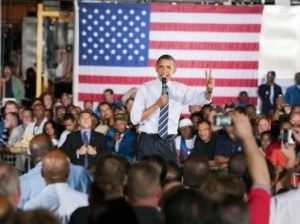Compromise seems to be the watchword for the White House, and even as the president continues to seek consensus on a bill raising the federal debt limit it appears the administration might also aim for an acceptable alternative to the 56.2 mpg fuel economy standard it floated several weeks ago.
While already below the original proposal of 62 miles per gallon in 2025, the numbers still didn’t add up for most automakers. Only Hyundai, of all major manufacturers, had indicated its belief it might even be able to come close. Industry lobbyists gained a strong ally in their fight in the form of the United Auto Workers Union, which argued that a significant increase in the Corporate Average Fuel Economy, or CAFE, standard could cost potentially 100s of thousands of jobs.
While Washington still appears to be set on the 56.2 mpg number for passenger cars, which would be a 5% annual increase over the 2016 standard of 37.5mpg, it is now raising the possibility of a reduced standard for light trucks. A report in the Wall Street Journal quotes sources who say the requirement for SUVs, pickups and other trucks would climb only 3.5% annually.
That actually would not set a new precedent. Until recently, light trucks have traditionally had their own CAFE standards, often as much as 20% lower than the mileage requirements for passenger cars.
But while the two-tiered approach might please industry and union officials it could create a firestorm among environmentalists and proponents of tough new rules aimed at curbing CO2 emissions and limiting dependence upon foreign oil.
In particular, insiders worry that the State of California could balk. Under federal law, the Golden State is allowed to set its own emissions rules and it has threatened to use that power to create higher CAFÉ targets in the past. In fact, the Obama Administration had to work hard to get California regulators, environmentalists and auto industry officials to sign on, two years ago, when the 2016 rules were finalized.
“This is the same shortsighted thinking that got the U.S. automakers in trouble in 2008 when gas prices caused them to be loaded with expensive SUV inventories that just wouldn’t sell,” said Jack Gillis, CFA Director of Public Affairs and author of The Car Book. “The tragic irony is that this kind of compromise will insure U.S. vehicles remain non-competitive in the global market.”
While high-mileage proponents insist that promising new technologies – such as direct injection, 8-speed gearboxes and plug-in hybrid systems — are being developed, the industry counters that those technologies won’t go far enough, at least not without a dramatic downsizing of the nation’s automotive fleet. That’s a particularly serious problem for Detroit which traditionally generates most of its profits off light trucks. But even Japanese makers like Toyota and Nissan have become increasingly dependent on big trucks and crossovers.
A recent study by the Center for Automotive Research, in Ann Arbor, Michigan, bolstered such concerns, warning that the tough government proposal could cost an average of nearly $10,000 a vehicle to meet. That would result in millions of Americans dropping out of the new car market and cost hundreds of thousands of jobs, it warned.
But the CAR study was countered by a report from the Boston Consulting Group which put the price tag closer to $2,000 a vehicle — a figure that it estimated would readily be offset by fuel savings, especially if gas prices continue to climb.


“…as Jack Gillis author of the Car Book said, the tragic irony is that this kind of compromise will insure US vehicles remain non-competitive in the global market”
Another irony comes from the records of the USPTO, the top Patent Office: Hyundai, Volvo, Fiat… have reasons to be optimistic.
VOLVO is already at 62.5 miles/gallon with their new Diesels and Fiat is close with their MultiAir, TwinAir gas engines.
California can start with them and make the math to find out the change the OPOC engine of Bill Gates can bring about. There is no Natural Law that dictates that a powerful engine must compromise with gas-guzzling and air-polluting.
A decade ago Bill Gates said that the Big Three were unable to see the basic principles, now his ECOMOTORS is set to make the engine and prove him right.
Manousos Pattakos